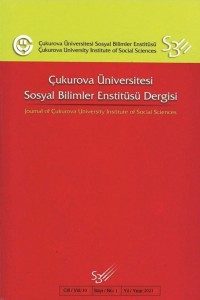Abstract
Kilikya ve komşu yerlerde deniz tasvirlerine özel bir ilgi bulunmaktadır. Bu ilgiyi deniz canlılarının özelliklerinin doğru tasvir edilmesi ve Kilikyalı Ozan Oppian’ın balıklar üzerine yazdığı Halieutiká adlı eseri kanıtlamaktadır. Anazarbos antik kentinde deniz canlılarının betimlendiği iki adet mozaik döşemesi bulunmaktadır. Mozaikler kentin güneybatı bölümünde yer alan villalara ait havuzların tabanlarını süslemektedir. Kentin önemli eserlerinden olan bu mozaikler Tethys mozaiği ve balıklar mozaiğidir. Deniz tanrıçası Tethys, Yunan tanrılarının hiyerarşisinde yüksek bir konuma sahiptir. Ancak daha sonraları Yunan ve Roma sanatında denizin kişileştirilmesi olarak anılacaktır. Tethys, denizden çıplak omuzlu olarak yükselen, sağ omzuna karşı bir açıda duran altın bir dümen ile tasvir edilmiştir. Kanatlı bir deniz tanrıçası olan Tethys figürünün Anazarbos kentinde farklı tarzda verilmesi, balıkların büyük boyutlu olarak tasvir edilmesi klasik ikonografi için önemlidir. Anazarbos mozaiklerinin tarzı klasik natüralizmin belirli özelliklerini korumaktadır. Bu yazıda Anazarbos Tethys mozaiği ve balıklar mozaiği tanıtılmakta, stil kritiği ile mozaik sanatındaki yeri belirlenmeye çalışılmıştır.
References
- Altay, H. (1968). Anavarza Mozayikleri hakkında ön rapor. Türk Arkeoloji Dergisi, 15-2, 49-54.
- Balty, J. (1981). La mosaïque antique au Proche-Orient. Aufstieg und Niedergang Der Römischen Welt 12.2, 348-427.
- Budde, L. (1972). Antike Mosaiken in Kilikien. Vol. 2, Recklinghausen: Aurel Bongers.
- Burrell, B. (2004). Neokoroi, Greek Cities and Roman Emperors. Leiden, Boston: Brill.
- Campbell, W. A. (1934). Excavations at Antioch-On-The-Orontes. American Journal of Archaeology, 38/2, 201-206.
- Campbell, W. A. (1938). The Fourth and Fifth Seasons of Excavation at Antioch-on-the-Orontes: 1935-1936. American Journal of Archaeology, 42/2, 205-217.
- Campbell, S. D. (1988). The Mosaics of Antioch, The Corpus of Mosaics Pavements in Turkey. Toronto: Pontifical Institute of Mediaeval Studies.
- Cimok, F. (2000). Corpus of Antioch Mosaics. İstanbul.
- Dorigo, W. (1971). Late Roman Painting. Praeger Publishers, New York.
- Gough, M. (1952) Anazarbus. Anatolian Studies, Vol. 2, 85-150.
- Levi, D. (1947). Antioch Mosaic Pavements. Vols. I, II. Princeton.
- Oppian of Cilicia. Halieutiká I. 554-580, Çeviri: A. W. Mair (London, 1928).
- Önal, M. (2002). Mosaics of Zeugma. A Turizm Yayınları.
- Uysal, T., Bulgan, F. (2016). Gaziantep Zeugma Mozaik Müzesi. İstanbul, 79-82.
- Wages, S. M. (1986). A Note on the Dumbarton Oaks Tethys Mosaic. Dumbarton Oaks Papers, Vol. 40, 119-128.
Abstract
There is a special interest in sea depictions in Cilicia and neighboring regions. This interest is evidenced by the correct depiction of the characteristics of the sea creatures and the work Halieutica written about fish by the Cilician poet Oppian. In the ancient city of Anazarbos, there are two mosaic floors depicting sea creatures. Mosaics decorate the floors of the pools belonging to a villa in the southwestern part of the city. These mosaics, one of the important works of the city, depict Tethys and fish. The sea goddess Tethys occupied a high state in the hierarchy of the Greek gods. In later Greek and Roman art, however, she was referred to as the personification of the sea. Tethys is depicted rising bare shouldered from the sea, with a golden rudder resting at an angle against her right shoulder. It is of importance for the classical iconography, to give figure of Tethys, a winged sea goddess, in the city of Anazarbos in a different style, and to depict the fish in large size. In its style the Anazarbos mosaics retain certain features of classical naturalism. In this article, Anazarbos Tethys mosaic and fish mosaic are presented and their state in mosaic art is tried to be determined by style criticism.
References
- Altay, H. (1968). Anavarza Mozayikleri hakkında ön rapor. Türk Arkeoloji Dergisi, 15-2, 49-54.
- Balty, J. (1981). La mosaïque antique au Proche-Orient. Aufstieg und Niedergang Der Römischen Welt 12.2, 348-427.
- Budde, L. (1972). Antike Mosaiken in Kilikien. Vol. 2, Recklinghausen: Aurel Bongers.
- Burrell, B. (2004). Neokoroi, Greek Cities and Roman Emperors. Leiden, Boston: Brill.
- Campbell, W. A. (1934). Excavations at Antioch-On-The-Orontes. American Journal of Archaeology, 38/2, 201-206.
- Campbell, W. A. (1938). The Fourth and Fifth Seasons of Excavation at Antioch-on-the-Orontes: 1935-1936. American Journal of Archaeology, 42/2, 205-217.
- Campbell, S. D. (1988). The Mosaics of Antioch, The Corpus of Mosaics Pavements in Turkey. Toronto: Pontifical Institute of Mediaeval Studies.
- Cimok, F. (2000). Corpus of Antioch Mosaics. İstanbul.
- Dorigo, W. (1971). Late Roman Painting. Praeger Publishers, New York.
- Gough, M. (1952) Anazarbus. Anatolian Studies, Vol. 2, 85-150.
- Levi, D. (1947). Antioch Mosaic Pavements. Vols. I, II. Princeton.
- Oppian of Cilicia. Halieutiká I. 554-580, Çeviri: A. W. Mair (London, 1928).
- Önal, M. (2002). Mosaics of Zeugma. A Turizm Yayınları.
- Uysal, T., Bulgan, F. (2016). Gaziantep Zeugma Mozaik Müzesi. İstanbul, 79-82.
- Wages, S. M. (1986). A Note on the Dumbarton Oaks Tethys Mosaic. Dumbarton Oaks Papers, Vol. 40, 119-128.
Details
| Primary Language | Turkish |
|---|---|
| Journal Section | Articles |
| Authors | |
| Publication Date | April 30, 2021 |
| Submission Date | March 31, 2021 |
| Published in Issue | Year 2021 Volume: 30 Issue: 1 |


